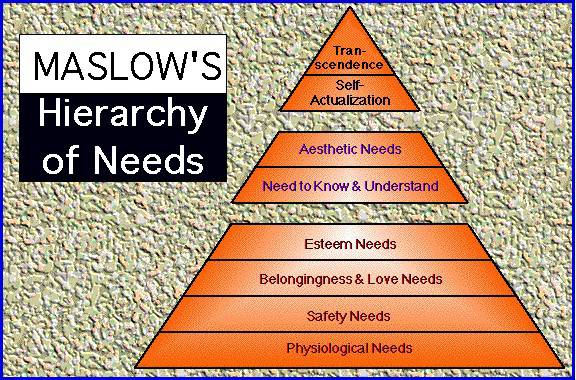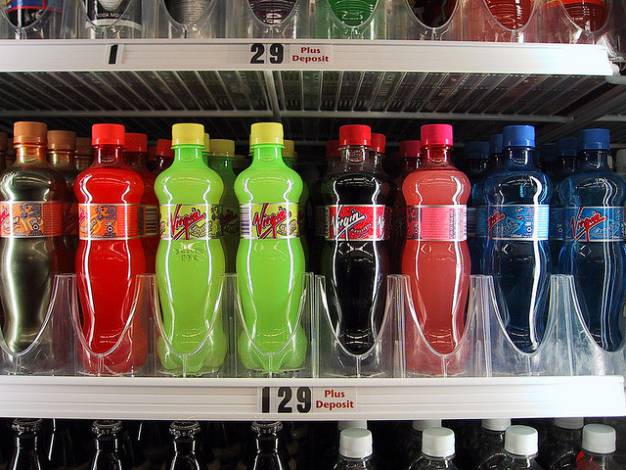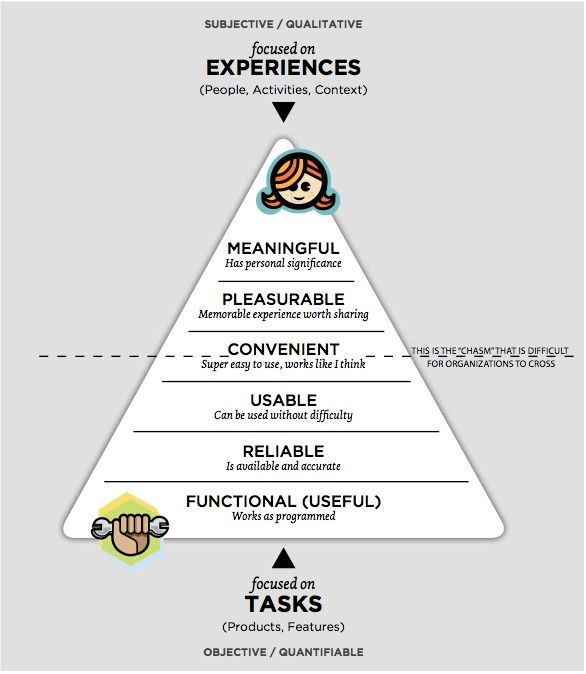User needs are no different from our general needs. We want to buy things to eat, drink, keep us clothed, and that make us happy in ourselves; we want to develop skills and learn, to help us realise our potential; we want to connect with friends and family to feel loved and to smooth the rough edges of everyday life, and we want to achieve a sense of security. Once we start using a product, these needs don't go away; they are always there at the back of our mind, driving our behaviour.

Author/Copyright holder: Purple Slog. Copyright terms and licence: CC BY 2.0
Maslow's Hierarchy of Needs, something that will be familiar to many psychology students, plots these basic human needs in a pyramid to capture the drives we have and how satisfying one need enables us to satisfy the next. Abraham Maslow (1908 - 1970) split the human needs into five separate levels: physiological, safety, love/belonging/esteem/and self-actualisation. Maslow suggested that humans are driven at first to satisfy their physiological needs (he must be right; have you ever tried to concentrate on work whilst being hungry/tired/thirsty?), and unless we do so, we are unable to realise the other needs higher up, which give us our sense of self.

Author/Copyright holder: Henry Faber. Copyright terms and licence: CC BY-NC 2.0
For each of the levels of Maslow's hierarchy we can recognise these needs in the drives displayed by users. Advertising represents one of the clearest examples of Maslow's hierarchy of needs influencing design. It would be quicker to name products that are not advertised using models (male and/or female) to tap into the physiological need for the 's' word. Such is the power of harnessing the basic human needs, even where there is no genuine link between a product and one of the basic physiological needs, this does not stop advertisers from playing (or should that be preying?) on one or more of them to grab our attention and get us to part with our money. Take Richard Branson's failed attempt to get a piece of the soft drink market, with Virgin Cola, which had a bottle design apparently modelled on Pamela Anderson's figure.

Author/Copyright holder: Unknown. Copyright terms and licence: Unknown. Img
Human needs should also be considered when you are trying to highlight the positive aspects of your products. For example, if you are selling drinks, images and text which draw attention to or accentuate the thirst-quenching nature of the product can improve its appeal. Likewise, a package holiday deal can seem a lot more attractive if you show people enjoying a meal and a few drinks (i.e. two physiological needs). Regardless of the product you are working on, it will be for some human need, whether it is to satisfy a physiological, safety, love/belonging, esteem, or a self-actualisation need; if there is no need then you should probably look at starting another project.
In Summary
When you look at your designs, ask yourself what needs you are trying to fulfil. If something doesn't address one of the human needs categorised by Maslow, where is its niche? Why should someone buy something if they have no need for it? Need and want are not distinct in this sense; even when we want something it is to satisfy one of our needs. So you can also ask, why would someone want this product? And again, if you can't answer this question you probably aren't onto a winner.
Maslow's hierarchy of needs can help you look at your designs in a different way. Design isn't a unique domain; you are dealing with the same drives as someone who works in a MacDonald's or a school, a fire station, a bank, and on and on we go. Look at your projects in terms of need and new insights await.
Header Image: Author/Copyright Holder: Bright Ideas Teaching. Copyright terms and licence: All rights reserved Img Source











